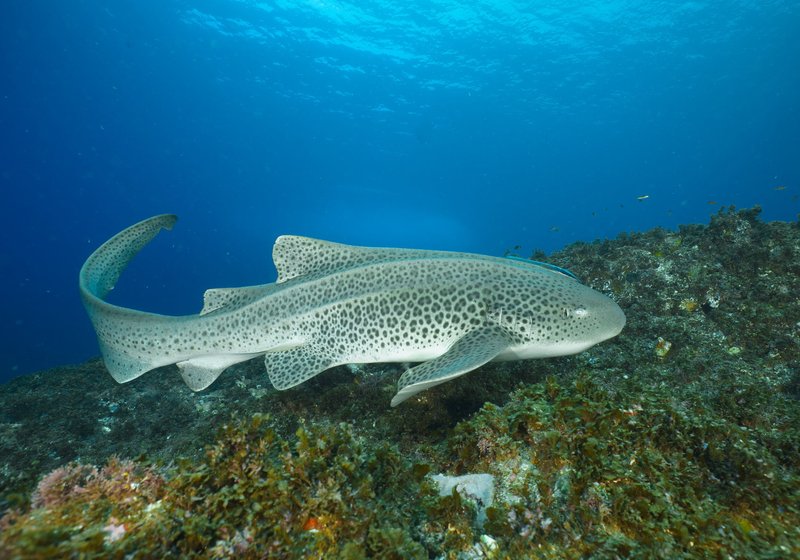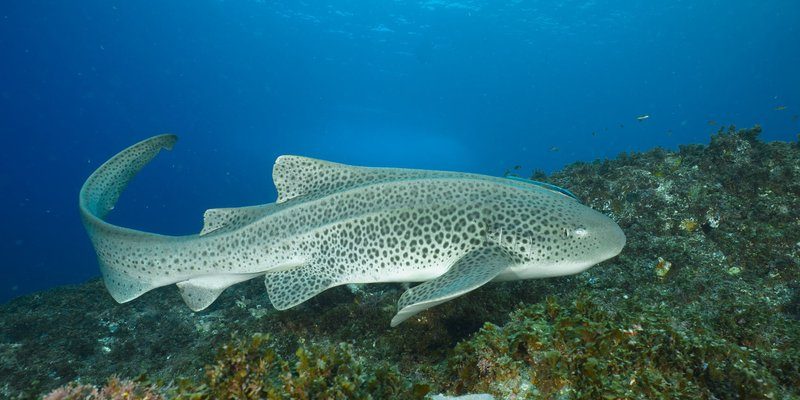
The Zebra Shark, also lovingly known as the leopard shark due to its distinctive patterns, is one of the ocean’s most intriguing creatures. Imagine the calming waves gently rocking you while you gaze into the clear blue waters and spot this unique shark gracefully gliding with a sleepy elegance. Their long, slender bodies and stunning markings make them truly stand out in the marine world. But there’s so much more to this species beyond just its looks!
You might be wondering where these sharks call home or what they eat. Well, the Zebra Shark is often found in warm coastal waters, particularly in Southeast Asia and around the Great Barrier Reef. They thrive in sandy or rocky environments and prefer shallow areas where they can easily hunt. These sharks tend to dine on a diet of mollusks, crustaceans, and small fish, showing a surprisingly diverse palate.
Physical Characteristics of the Zebra Shark
The most noticeable feature of the Zebra Shark is its unique coloring. Young Zebra Sharks are spotted with beautiful dark brown and yellow patterns, giving them a leopard-like appearance. However, as they mature, these spots fade into stripes, resembling a zebra. This change is not just cosmetic; it also aids in camouflage throughout different stages of life. Adult Zebra Sharks can grow up to 11 feet long, although many average around 6 to 10 feet.
Another fascinating aspect is their body shape. Zebra Sharks have elongated, flattened bodies and wide heads, which help them navigate through rocky crevices and coral reefs with ease. Their pectoral fins are large and help them steer, while their dorsal fins are distinctive and give them an almost playful look. With their gentle nature and unique appearance, they have become favorites among divers and snorkelers alike.
Habitat and Distribution
Zebra Sharks have a preference for shallow coastal waters that are rich in marine life. You can typically find them in sandy areas, coral reefs, and sometimes even in mangroves. They are native to the Indo-Pacific region, with their range stretching from the eastern coast of Africa to the western shores of the Americas. Their ability to thrive in various environments makes them adaptable, but it also makes them vulnerable to habitat loss due to human activity.
One of the key reasons Zebra Sharks are often found in these specific locations is because they use the sandy bottoms to hide from predators and ambush prey. The camouflage provided by their color patterns is essential for hunting. They can often be spotted resting on the ocean floor during the day, making them less active at this time. If you ever get the chance to dive in their habitat, keep your eyes peeled, as they might be resting just a stone’s throw away!
Diet and Feeding Habits
When it comes to food, Zebra Sharks are opportunistic feeders. They primarily feast on small fish, mollusks, and crustaceans, showcasing a varied diet that helps them thrive in their natural habitat. Their feeding strategy involves using their keen sense of smell to detect prey hidden in the sand or among rocks. Once they locate their meal, they employ a unique technique to suction in their food—a bit like a vacuum cleaner, if you will!
Interestingly, the Zebra Shark has a unique way of feeding that involves grazing along the ocean floor. They will often use their mouth to turn over shells and other debris to uncover hidden snacks. This method not only keeps them nourished but also plays a vital role in the health of their habitat. By disturbing the ocean floor, they help recycle nutrients, promoting a healthier ecosystem overall.
Behavior and Social Structure
Unlike some shark species that are known for their solitary nature, Zebra Sharks exhibit a more social behavior. They are often seen resting together in groups, particularly in areas with plenty of food. This behavior can be quite endearing, as it shows that they enjoy the company of their own kind. As nocturnal hunters, they become more active at night, often venturing out on their adventures while the ocean is quiet.
Communication among Zebra Sharks is subtle but fascinating. They use body language and subtle movements to express their emotions. If you’re lucky enough to see them interact, you might observe gentle nudges or playful swims. This camaraderie among sharks presents a different side to these often-misunderstood creatures. Rather than being terrifying predators, they showcase a more gentle and community-oriented behavior.
Reproduction and Lifespan
When it comes to reproduction, Zebra Sharks have a rather unique approach. They are oviparous, meaning they lay eggs rather than giving live birth. The female Zebra Shark typically lays around 4 to 7 egg cases at a time. These egg cases are often referred to as “mermaid’s purses,” and they possess a tough outer layer to protect the developing embryos inside. Over several months, the eggs gradually develop into tiny sharks, ready to venture into the world.
As for their lifespan, Zebra Sharks are known to live for around 25 years in the wild, but that number can vary based on environmental factors and threats. In captivity, where they can be monitored closely, their lifespan can reach up to 30 years or more. This longevity is a testament to their adaptability and resilience in different environments.
Conservation Status
Unfortunately, the Zebra Shark is currently classified as Vulnerable by the International Union for Conservation of Nature (IUCN). The main threats they face come from habitat loss, overfishing, and being caught as bycatch in fishing nets. Because they are often targeted for their fins and meat, their populations have started to decline in some regions. Conservation efforts are ongoing, but the need for awareness and education about these beautiful creatures is crucial.
Many aquariums and marine conservation organizations are working hard to protect the Zebra Shark and its habitat. By engaging in responsible fishing practices and supporting marine protected areas, we can all play a part in ensuring the survival of this unique species. Educating ourselves and others about the importance of marine ecosystems is vital to promoting conservation efforts for the Zebra Shark and its peers.
Table of Zebra Shark Facts
| Common Name: | Zebra Shark |
| Scientific Name: | Stegostoma fasciatum |
| Habitat: | Warm coastal waters, coral reefs |
| Diet: | Small fish, mollusks, crustaceans |
| Size: | Typically 6 to 10 feet; up to 11 feet |
| Lifespan: | Up to 25 years in the wild; over 30 in captivity |
| Conservation Status: | Vulnerable |
FAQ
What do Zebra Sharks look like?
Zebra Sharks have a unique appearance that changes as they grow. Young Zebra Sharks are dark brown with white spots, resembling a leopard. As they mature, their bodies develop into horizontal stripes, resembling a zebra. This transformation is not only captivating but also serves a purpose in their camouflage and hunting strategies.
Are Zebra Sharks dangerous to humans?
No, Zebra Sharks are generally considered harmless to humans. Their docile nature and preference for shallow waters make them less likely to encounter people. While they have teeth, they use them primarily for grasping prey rather than tearing flesh. Most interactions between Zebra Sharks and divers are peaceful and memorable.
How do Zebra Sharks reproduce?
Zebra Sharks are oviparous, which means they lay eggs. The female produces egg cases, which are tough and protective structures that safeguard the developing embryos. After a few months, the baby sharks hatch from the cases, ready to begin their life in the ocean. This method of reproduction is quite fascinating and different from many other shark species.
What is the habitat of the Zebra Shark?
Zebra Sharks inhabit warm coastal waters, often residing in sandy or rocky areas. They are commonly found in the Indo-Pacific region, including the Great Barrier Reef. Their preference for shallower waters allows them to hunt effectively and find shelter from larger predators.
How fast can Zebra Sharks swim?
While Zebra Sharks are not the fastest swimmers in the ocean, they can reach speeds of up to 3 miles per hour (about 5 kilometers per hour) when they need to. Their graceful movements and ability to glide through the water allow them to conserve energy while hunting and exploring their surroundings.
Do Zebra Sharks have any natural predators?
Yes, Zebra Sharks face threats from larger predators such as bigger shark species, including tiger sharks and great white sharks. However, their unique coloring and behavior help them avoid detection as they hide in rocks and sandy areas during the day.
Can Zebra Sharks live in aquariums?
Yes, Zebra Sharks can be kept in aquariums, and many facilities around the world have successfully done so. Their gentle nature and unique appearance make them a popular choice for marine exhibits. Proper care, ample space, and a suitable environment are crucial for their well-being in captivity.
What can we do to help protect Zebra Sharks?
We can support Zebra Shark conservation by spreading awareness about their vulnerabilities and understanding the importance of marine ecosystems. Supporting organizations focused on marine wildlife and advocating for responsible fishing practices are also essential steps. By becoming educated and engaged, we can help protect these magnificent creatures and their ocean homes.
What is a unique fact about Zebra Sharks?
One interesting fact about Zebra Sharks is that they can actually use their pectoral fins to “walk” on the ocean floor! This adaptation helps them explore their environment more efficiently, allowing them to navigate rocky or uneven surfaces while searching for food. It’s just another great example of how fascinating these creatures truly are!
How long does it take for Zebra Shark eggs to hatch?
The eggs laid by Zebra Sharks typically take around 3 to 6 months to hatch, depending on environmental conditions such as water temperature. Once the baby sharks are ready to emerge, they break free from their protective egg cases, setting off on their own journey into the ocean.
What is the role of Zebra Sharks in their ecosystem?
Zebra Sharks play a significant role in their ecosystem by helping maintain the balance of marine life. As predators, they keep populations of their prey in check, which in turn supports the health of the coral reefs and sandy environments where they live. Their feeding habits help recycle nutrients, contributing to the overall health of the underwater ecosystem.

